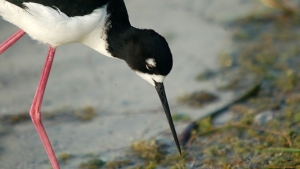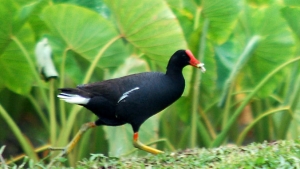
Expanded restoration of Indigenous practices will more than compensate for projected losses of endangered waterbird habitat. These findings of an interdisciplinary team of researchers at the University of Hawaiʻi at Mānoa and Kamehameha Schools may provide useful information in discussions at the federal level to down-list the endangered aeʻo (Hawaiian Stilt, Himantopus mexicanus knudseni) to the level of "threatened."
"Much of the aeʻo's core nesting habitat, which is the foundation of its increasing population numbers, is projected to be gone by 2100 due to sea-level rise," said Kristen Harmon, a PhD candidate in the Department of Natural Resources and Environmental Management at the College of Tropical Agriculture and Human Resources (CTAHR), and the paper's lead author.

While the aeʻo population has been increasing in the past decades, it has not yet reached 2,000 individuals—a key threshold for downlisting.
"Aeʻo only have a 7% survival rate from egg to fledging due to heavy predation from invasive mammals, birds, bullfrogs, and even crabs!" added Melissa Price, a UH Mānoa professor who runs the CTAHR Wildlife Ecology Lab. "That's a very concerning level of survival, unlikely to result in recovery unless we can address the invasive predator and nesting habitat issues."
Researchers hopeful for bird's future
Despite the dangers, the team of researchers remains optimistic.
"We know that loʻi, or wetland taro fields, provide habitat for all of our endangered waterbirds, including aeʻo," said Kawika Winter, an ecologist at UH Mānoa's Hawaiʻi Institute of Marine Biology and co-author on the paper, who added that breeding success in loʻi are the same as in wetlands managed purely for wildlife conservation.
Natalie Kurashima, Integrated Resources Manager at Kamehameha Schools and a co-author on the paper said, "This research shows that restoration of loʻi in suitable areas under climate change could increase aeʻo habitat by 171%, even after accounting for losses due to sea-level rise."
"There is no scenario in which the sea-level does not keep rising for centuries. Nature is our best ally in meeting this challenge," noted Chip Fletcher, a climate scientist at UH Mānoa's School of Ocean and Earth Science and Technology and co-author of this study.
This research shows the value of Indigenous knowledge and practice in contemporary times.

"Our belief is that the best way to respond to environmental change is to look to and be guided by local ancestral wisdom and practice. Sea-level rise will have the added benefit of expanding freshwater wetland areas providing habitat for waterbirds and a crop synonymous with Hawaiian identity," said Haunani Kane, the first Indigenous (Native Hawaiian) woman to receive a doctorate degree in geology and geophysics at UH Mānoa and a co-author of the study.
The research findings were published in Anthropocene.
This work is an example of UH Mānoa's goal of Excellence in Research: Advancing the Research and Creative Work Enterprise (PDF), one of four goals identified in the 2015–25 Strategic Plan (PDF), updated in December 2020.






